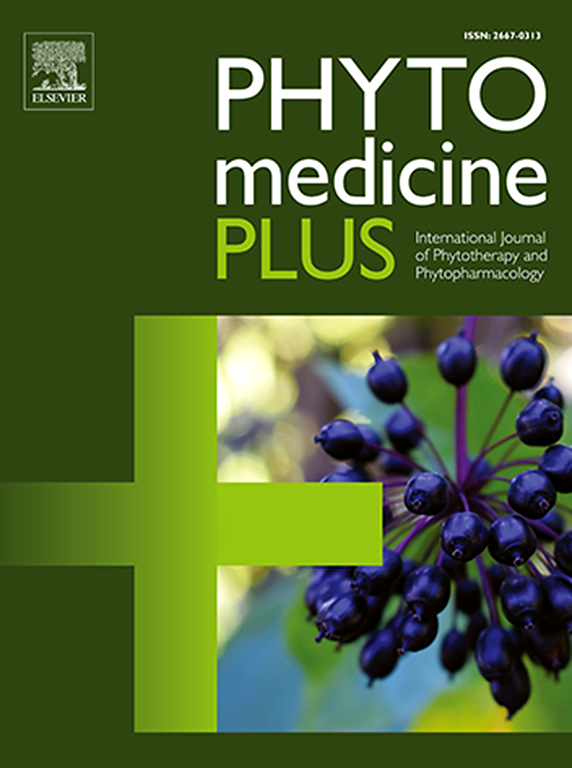Molecular and biochemical responses in Wistar rats treated with extracts from a hyperglycemia and diabetes-associated therapeutic Hensia crinita
Q3 Pharmacology, Toxicology and Pharmaceutics
引用次数: 0
Abstract
Background
Diabetes, marked by insulin resistance, disrupts metabolic processes and causes significant complications. Herbal remedies are increasingly recognized for their potential in diabetes management, particularly in developing countries.
Purpose
To study the effects of Hensia crinita (H. crinita) extract on hyperglycemia and related therapeutic responses in Wistar rats.
Methods
Type 2 diabetes was induced with 10% fructose diet and 40 mg/kg streptozotocin (STZ). Thereafter, diabetic rats were treated with H. crinita leaf extracts at 200 and 400 mg/kg body weight, twice daily for 21 days. We used metformin (MET: 500 mg/kg body weight) treated rats as a positive control group.
Results
Our results showed that H. crinita extract significantly lowered fasting blood glucose (FBG) levels and increased body weight in diabetic rats. Molecular analysis revealed reductions in mRNA expression for insulin-responsive glucose transporter (ir-glut), leptin, proprotein convertase subtilisin/kexin type 9 (pcsk9), cardiac troponin (crt), estrogen receptor 1 (esr-1), fatty acid synthase (fasn) and melatonin (mt) in treated rats, compared to controls. Furthermore, hepatic biochemical analysis showed that AST, ALT, ALP and γ-GGT increased in diabetic control animal and H. crinita produced decreases that paralleled melatonin effects. Additionally, H. crinita treatment increased plasma estradiol (E2) and testosterone (T) levels and significantly reduced inflammatory markers, and these responses were comparable to MET effects.
Conclusion
These findings suggest that H. crinita exerts anti-hyperglycemic effects by modulating inflammation, hormonal balance, and key glucose metabolic enzymes, representing a potential therapeutic agent for diabetes treatment.

用高血糖和糖尿病相关治疗的荆芥提取物治疗Wistar大鼠的分子和生化反应
糖尿病以胰岛素抵抗为特征,扰乱代谢过程并引起严重并发症。草药疗法在糖尿病管理方面的潜力日益得到认可,特别是在发展中国家。目的研究茜草提取物对Wistar大鼠高血糖的影响及相关治疗效果。方法采用10%果糖日粮加40 mg/kg链脲佐菌素(STZ)诱导2型糖尿病。随后,以200和400 mg/kg体重的麻叶提取物治疗糖尿病大鼠,每天2次,连续治疗21 d。采用二甲双胍(MET: 500 mg/kg体重)治疗大鼠作为阳性对照组。结果荆芥提取物能显著降低糖尿病大鼠的空腹血糖水平,增加体重。分子分析显示,与对照组相比,治疗大鼠的胰岛素应答型葡萄糖转运蛋白(ir-glut)、瘦素、枯草素/ keexin 9型蛋白转化酶(pcsk9)、心肌肌钙蛋白(crt)、雌激素受体1 (esr-1)、脂肪酸合成酶(fasn)和褪黑激素(mt) mRNA表达减少。此外,肝脏生化分析显示,糖尿病对照动物的谷丙转氨酶、谷丙转氨酶、谷丙转氨酶和γ-GGT均升高,而红毛鼠的谷丙转氨酶和γ-GGT均降低,与褪黑素作用平行。此外,荆芥治疗增加了血浆雌二醇(E2)和睾酮(T)水平,并显著降低了炎症标志物,这些反应与MET效果相当。结论荆芥通过调节炎症、激素平衡和关键糖代谢酶发挥抗高血糖作用,是一种潜在的治疗糖尿病的药物。
本文章由计算机程序翻译,如有差异,请以英文原文为准。
求助全文
约1分钟内获得全文
求助全文
来源期刊

Phytomedicine Plus
Medicine-Complementary and Alternative Medicine
CiteScore
3.70
自引率
0.00%
发文量
178
审稿时长
81 days
期刊介绍:
 求助内容:
求助内容: 应助结果提醒方式:
应助结果提醒方式:


